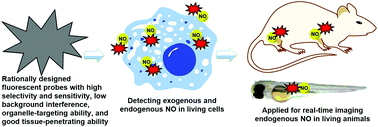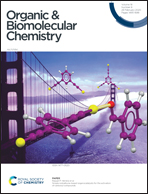Recent progress on the organic and metal complex-based fluorescent probes for monitoring nitric oxide in living biological systems
Abstract
Nitric oxide (NO) is an important gaseous signaling molecule related to various human diseases. To investigate the biological functions of NO, many strategies have been developed for real-time monitoring the NO levels in biological systems. Among these strategies, fluorescent probes are considered to be one of the most efficient and applicable methods owing to their excellent sensitivity and selectivity, high spatiotemporal resolution, noninvasiveness, and experimental convenience. Therefore, great efforts have been paid to the design, synthesis, and fluorescence investigation of novel NO fluorescent probes in the past several years. However, few of them exhibit practical applications owing to the low concentration, short half-life, and rapid diffusion characteristics of NO in biological systems. Rational design of NO fluorescent probes with excellent selectivity and sensitivity, low cytotoxicity, long-lived fluorescent emission, and low background interference is still a challenge for scientists all over the word. To provide spatial-temporal information, this article focuses on the progress made in the organic and metal complex-based NO fluorescent probes during the past five years. The key structural elements and sensing mechanisms of NO fluorescent probes are discussed. Some novel ratiometric, luminescence, and photoacoustic probes with low background interference and deep tissue penetrating ability are mentioned. All these probes have been used for imaging exogenous and endogenous NO in cells and animal models. More importantly, this article also describes the development of multi-functional NO fluorescent probes, such as organelle targeting probes, dual-analysis probes, and probe-drug conjugates, which will inspire the design of various functional fluorescent probes.



 Please wait while we load your content...
Please wait while we load your content...